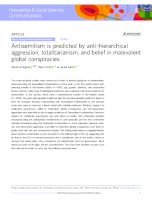Antisemitism is predicted by anti-hierarchical aggression, totalitarianism, and belief in malevolent global conspiracies
Author(s)
Publication Name
Publication Date
Abstract
Two cross-sectional studies were carried out in order to identify predictors of antisemitism, measured using the Generalised Antisemitism or GeAs scale. In the first, which used a self-selecting sample of UK-resident adults (n = 809), age, gender, ethnicity, and educational level as well as a wide range of ideological predictors were analysed as bivariate predictors of antisemitism. In the second, which used a representative sample of UK-resident adults (n = 1853), the same demographic predictors plus the non-demographic predictors found to have the strongest bivariate relationships with Generalised Antisemitism in the previous study were used to construct a linear model with multiple predictors. Ethnicity, support for totalitarian government, belief in malevolent global conspiracies, and anti-hierarchical aggression were identified as the strongest predictors of Generalised Antisemitism. However, support for totalitarian government was only found to predict ‘old’ antisemitic attitudes (measured using the Judeophobic Antisemitism or JpAs subscale) and not ‘new’ antisemitic attitudes (measured using the Antizionist Antisemitism or AzAs subscale), whereas ethnicity, anti-hierarchical aggression, and belief in malevolent global conspiracies were found to predict both ‘old’ and ‘new’ antisemitic attitudes. This finding adds nuance to ongoing debates about whether antisemitism is more prevalent on the political right or left, by suggesting that (at least in the UK) it is instead associated with a conspiracist view of the world, a desire to overturn the social order, and a preference for authoritarian forms of government—all of which may exist on the right, the left, and elsewhere. Data from both samples are open, as is the code used in order to carry out the analyses presented here.
Topics
Genre
Geographic Coverage
Copyright Info
This article is licensed under a Creative Commons
Attribution 4.0 International License, which permits use, sharing,
adaptation, distribution and reproduction in any medium or format, as long as you give
appropriate credit to the original author(s) and the source, provide a link to the Creative
Commons license, and indicate if changes were made. The images or other third party
material in this article are included in the article’s Creative Commons license, unless
indicated otherwise in a credit line to the material. If material is not included in the
article’s Creative Commons license and your intended use is not permitted by statutory
regulation or exceeds the permitted use, you will need to obtain permission directly from
the copyright holder. To view a copy of this license, visit http://creativecommons.org/
licenses/by/4.0/.
Attribution 4.0 International License, which permits use, sharing,
adaptation, distribution and reproduction in any medium or format, as long as you give
appropriate credit to the original author(s) and the source, provide a link to the Creative
Commons license, and indicate if changes were made. The images or other third party
material in this article are included in the article’s Creative Commons license, unless
indicated otherwise in a credit line to the material. If material is not included in the
article’s Creative Commons license and your intended use is not permitted by statutory
regulation or exceeds the permitted use, you will need to obtain permission directly from
the copyright holder. To view a copy of this license, visit http://creativecommons.org/
licenses/by/4.0/.
Original Language
Volume/Issue
10
Page Number / Article Number
155
DOI
Link
Link to article including link to pdf, Antisemitism is predicted by anti-hierarchical aggression, totalitarianism, and belief in malevolent global conspiracies
Bibliographic Information
Antisemitism is predicted by anti-hierarchical aggression, totalitarianism, and belief in malevolent global conspiracies. 2023: 155. https://archive.jpr.org.uk/10.1057/s41599-023-01624-y




